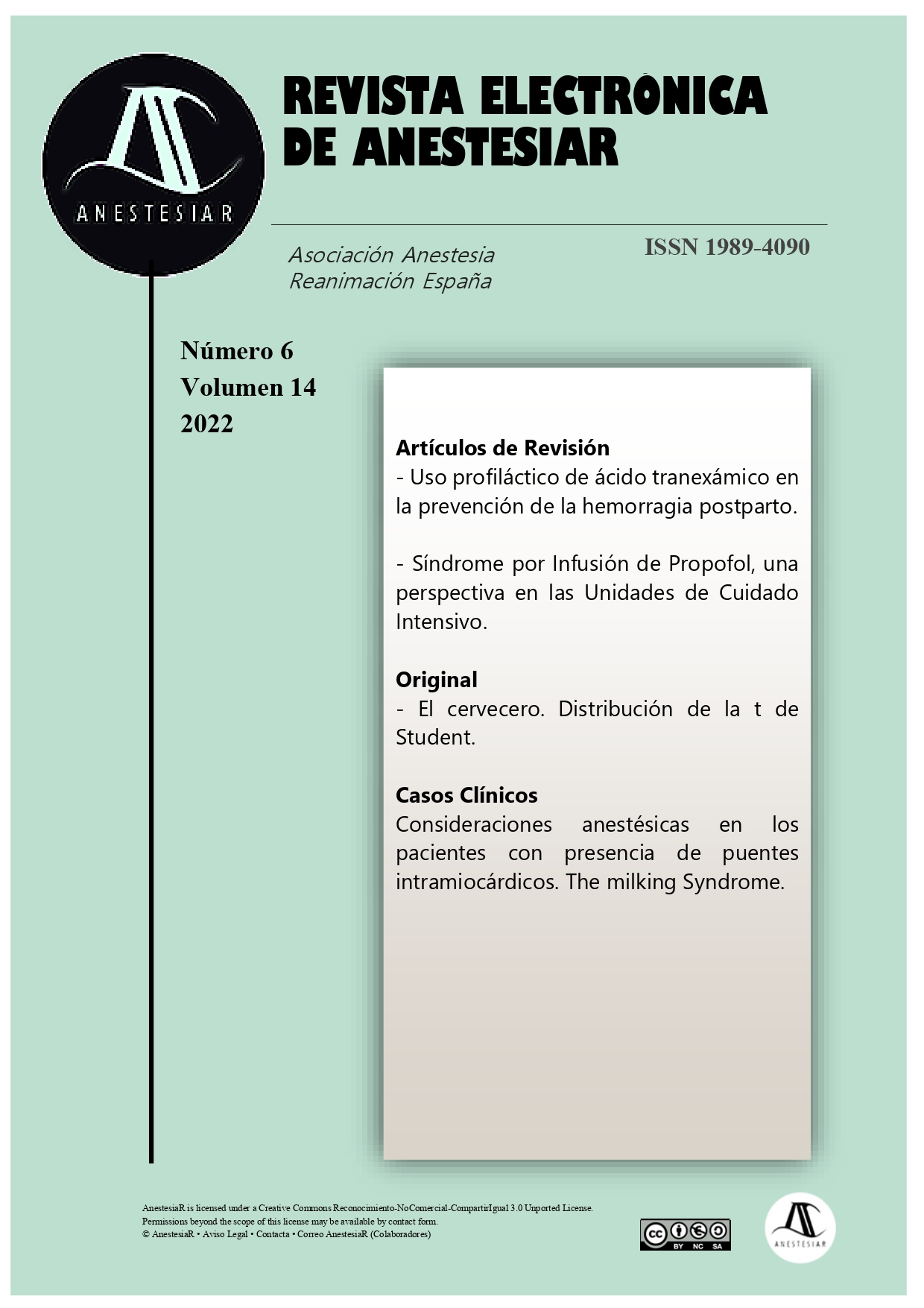Propofol Infusion Syndrome, a perspective in Intensive Care Units
DOI:
https://doi.org/10.30445/rear.v14i6.1089Keywords:
Propofol; Propofol Infusion Syndrome; Dosage; Critical Care; Mortality; Complications.Abstract
Introduction. Propofol in one of the most widely used hypnotic for sugical procedures due to its rapid onset and reversal,currently wit great importance in critical care units for sedation given the possibility of tachyphylaxis in this type of patint. despide having and adequate safety profile, there is a direct relationship between high doses (>4mg/kg/hour) and prolonged (>48 hours) with propofol infusion syndrome, a rare and potentially fatal condition characterized primarily by acidosis metabolic, cardiovascular disorders, rhabdomyolysis and hyperkalemia. The incidence of this complication is around 1.1%. The objetive is to carry out a bibliographic review on the propofol infusion syndrome presenting the importance of the prevention, diagnosis and management of thie entity with its implications in intensive care units. Material and methods: Aliterature search was carried out in the PunMed and Scielo databases for updated and relevant articles in English of Spanish presenting the importance of prevention, diagnosis and pharmacological management. COnclusion: propofol infusion syndrome is a rare complication with high mortality, for which in-hospital strategies and protocols should be established for inmediate management in cases of suspicion or diagnosis in a timely manner.
References
Hemphill S, McMenamin L; Bellamy MC, Hopkins PM. Propofol infusion syndrome: a structured literature review and analysis of published case reports. Br J Anasth. 2019 Apr; 122(4): 448-459. doi: 10.1016/j.bja.2018.12.025.
Sumi C, Okamoto A, Tanaka H, Nishi K, Kusunoki M, Shoji T, et al. Propofol induces a metabolic switch to glycolysis and cell death in a mitochondrial electron transport chain-dependent manner. PLoS One. 2018; 13(2): e0192796. doi: 10.1371/journal.pone.0192796.
Dehesa-Lopez E, Irizar-Santana SS, Granado RC, Ortiz RV. Propofol Infusion Syndrome in the Postoperative Period of a Kidney Transplant. Case Rep Nephrol. 2019; 2019: 7498373. doi: 10.1155/2019/7498373.
Hwang WS, Gwak HM, Seo DW. Propofol Infusion Syndrome in Refractory Status Epilepticus. J Epilepsy Res. 2013 Jun 30;3(1):21-7. doi: 10.14581/jer.13004.
Wolf A, Weir P, Segar P, Stone J, Shield J. Impaired fatty acid oxidation in propofol infusion syndrome. Lancet. 2001 Feb 24;357(9256):606-7. doi: 10.1016/S0140-6736(00)04064-2.
Caracci B, Aranda F. Síndrome de infusión por propofol en el adulto. Rev Chil Anest 2018; 47: 189-195. DOI:10.25237/revchilanestv47n03.05.
Flamée P, Varnavas V, Dewals W, Carvalho H, Cools W, Bhutia JT, et al. Electrocardiographic Effects of Propofol versus Etomidate in Patients with Brugada Syndrome. Anesthesiology. 2020 Mar;132(3):440-451. doi: 10.1097/ALN.0000000000003030.
Ellermann C, Konemann H, Wolfes J, Rath B, Wegner FK, Willy K, et al. Propofol abolishes torsade de pointes in different models of acquired long QT syndrome. Sci Rep. 2020 Jul 22;10(1):12133. doi: 10.1038/s41598-020-69193-7.
Finsterer J, Frank M. Propofol Is Mitochondrion-Toxic and May Unmask a Mitochondrial Disorder. J Chil Neurol. 2016 Nov;31(13):1489-1494. doi: 10.1177/0883073816661458.
Testerman GM, Chow TT, Easparam S. Propofol infusion syndrome: an algorithm for prevention. Am Surg 2011;77:1714–5.
Schroeppel TJ, Clement LP, Barnard DL, Guerrero W, Ferguson MD, Sharpe JP, et al. Propofol Infusion Syndrome: Efficacy of a Prospective Screening Protocol. Am Surg. 2018 Aug 1;84(8):1333-1338
Shimada M, Sakamoto M. Propofol Infusion Syndrome Treated Successfully by Early Diagnosis. Kyobu Geka. 2020 Dec;73(13):1061-1064.
Ichikawa T, Okuyama K, Kamata K, Masui K, Ozaki M. Suspected propofol infusion syndrome during normal targeted propofol concentration. J Anesth. 2020 Aug;34(4):619-623. doi: 10.1007/s00540-020-02773-z.
Katsuki M, Ozaki D, Narita N, Ishida N, Watanabe O, Cai S, et al. Unilateral posterior reversible encephalopathy syndrome characterized with a long and gradually exacerbating course over 3 years and that presented propofol infusion syndrome - A case report. Surg Neurol Int. 2021; 12: 19. doi: 10.25259/SNI_853_2020.
Vieira J, Frakes M, Cohen J, Wilcox S. Extracorporeal Membrane Oxygenation in Transport Part 2: Complications and Troubleshooting. Air Med J. Mar-Apr 2020; 39(2):124-132. doi: 10.1016/j.amj.2019.09.009.
Downloads
Published
How to Cite
Issue
Section
License
Copyright (c) 2022 Revista Electrónica AnestesiaR

This work is licensed under a Creative Commons Attribution-ShareAlike 4.0 International License.
 Envío y derechos de autor
Envío y derechos de autor


 Revista Electrónica AnestesiaR by
Revista Electrónica AnestesiaR by 